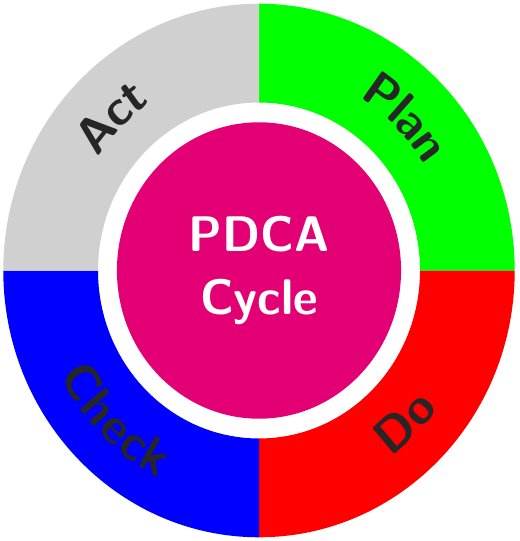|
Folgefrage zu „Tikz Cycle wie im Beispiel nur ohne Pfeile“ Wie kann ich jetzt noch die 4 Segmente in unterschiedlichen Farben darstellen? Hier mein MWE: \documentclass[tikz,border=10pt]{standalone} \usetikzlibrary{decorations.text} \definecolor{mygray}{RGB}{208,208,208} \definecolor{mymagenta}{RGB}{226,0,116} \newcommand*{\mytextstyletwo}{\sffamily\Large\bfseries\color{black!85}} \newcommand{\arcnoarrow}[3]{% % inner radius, middle radius, outer radius, start angle, % end angle, tip protusion angle, options, text \pgfmathsetmacro{\rin}{1.7} \pgfmathsetmacro{\rmid}{2.2} \pgfmathsetmacro{\rout}{2.7} \pgfmathsetmacro{\astart}{#1} \pgfmathsetmacro{\aend}{#2} \pgfmathsetmacro{\atip}{0} \fill[mygray, very thick] (\astart+\atip:\rin) arc (\astart+\atip:\aend:\rin) -- (\aend-\atip:\rmid) -- (\aend:\rout) arc (\aend:\astart+\atip:\rout) -- (\astart:\rmid) -- cycle; \path[ decoration = { text along path, text = {|\mytextstyletwo|#3}, text align = {align = center}, raise = -1.0ex }, decorate ](\astart+\atip:\rmid) arc (\astart+\atip:\aend+\atip:\rmid); } \begin{document} \begin{tikzpicture} \fill[even odd rule,mymagenta] circle (1.5); \node at (0,0) [ font = \mytextstyletwo, color = white, align = center ]{ PDCA\\ Cycle }; \arcnoarrow{ 90}{ 0}{Plan} \arcnoarrow{270}{360}{Do} \arcnoarrow{180}{270}{Check} \arcnoarrow{180}{ 90}{Act} \end{tikzpicture} \end{document} |
|
Wie bereits von saputello in einem Kommentar zu seiner Antwort auf die ursprüngliche Frage vorgeschlagen würde ich in diesem Fall die Parameter von \documentclass[tikz,border=10pt]{standalone} \usetikzlibrary{decorations.text} \definecolor{mygray}{RGB}{208,208,208} \definecolor{mymagenta}{RGB}{226,0,116} \newcommand*{\mytextstyletwo}{\sffamily\Large\bfseries\color{black!85}} \newcommand{\arcarrow}[4][]{% \pgfkeys{% /arcarrow/rin/.code={\pgfmathsetmacro{\rin}{##1}}, /arcarrow/rmid/.code={\pgfmathsetmacro{\rmid}{##1}}, /arcarrow/rout/.code={\pgfmathsetmacro{\rout}{##1}}, /arcarrow/atip/.code={\pgfmathsetmacro{\atip}{##1}}, /arcarrow/atip/.default=5, /arcarrow/rin=1.7, /arcarrow/rmid=2.2, /arcarrow/rout=2.7, /arcarrow/atip=0, /arcarrow/fill/.code={\colorlet{fillcolor}{##1}}, /arcarrow/fill=mygray, /arcarrow/.cd, #1 }% \pgfmathsetmacro{\astart}{#2} \pgfmathsetmacro{\aend}{#3} \fill[fillcolor, very thick] (\astart+\atip:\rin) arc (\astart+\atip:\aend:\rin) -- (\aend-\atip:\rmid) -- (\aend:\rout) arc (\aend:\astart+\atip:\rout) -- (\astart:\rmid) -- cycle; \path[ decoration = { text along path, text = {|\mytextstyletwo|#4}, text align = {align = center}, raise = -1.0ex }, decorate ](\astart+\atip:\rmid) arc (\astart+\atip:\aend+\atip:\rmid); } \begin{document} \begin{tikzpicture} \fill[even odd rule,mymagenta] circle (1.5); \node at (0,0) [ font = \mytextstyletwo, color = white, align = center ]{ PDCA\\ Cycle }; \arcarrow[fill=green]{ 90}{ 0}{Plan} \arcarrow[fill=red]{270}{360}{Do} \arcarrow[fill=blue]{180}{270}{Check} \arcarrow{180}{ 90}{Act} \end{tikzpicture} \end{document} Ich habe bei der Gelegenheit auch gleich Näheres zu BTW: Ich empfehle, Code immer sinnvoll, beispielsweise nach Klammerpaaren, einzurücken. Das macht ihn weit besser lesbar. Vergleiche einfach einmal deinen flachen Code mit meinem. Bei dir ist es weit schwerer, zusammengehörende Klammerpaare zu finden und so die Semantik zu erfassen. |

